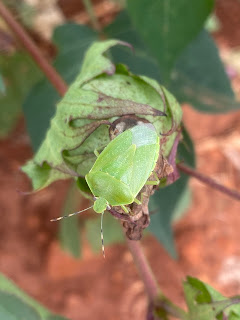We certainly had some challenging situations through the cotton production season in Alabama in 2022. From severe drought in some areas, to excessive rainfall in others weather played a major role in the in-season management of the crop. Even so, we expect to have a very good cotton crop in 2022. We have heard several reports of 3 or more bales per acre being picked and expect our state average to be around 900 lbs. According to data from the USDA, Alabama planted just over 425,000 acres of cotton this year.
Overall, insects were not a major yield limiting factor for
Alabama cotton in 2022. Many fields required multiple applications, as the
statewide average was ≈5 applications per acre. However, thanks to proper
scouting and the use of thresholds, the overall reduction of production caused
by insects is estimated to only be 2.94%.
To start the season, grasshoppers required attention
on many fields across Alabama, particularly on sandier, well drained soils and
those under reduced or no-till strategies. No losses are expected from
grasshopper feeding as insecticides applied at-burndown or at-planting are
generally effective in controlling populations and preventing economic losses.
For two seasons in a row, thrips pressure was higher in later planted
cotton. Most of our cotton acres received foliar treatments to supplement
at-plant insecticides (seed treatments or in-furrows). In many cases, the
biggest concern around making foliar thrips sprays was the risk of flaring
spider mites. In dry pockets, many farmers elected to use materials that are
less harsh on beneficial insects, even at a slightly higher price point. Other
pests such as slugs, snails or cutworms were observed and
reported in a few fields, but rarely at economic levels during the early
season.
.jpg) |
| Adult Tobacco Thrips |
 |
| Spider Mite Injury |
As the cotton crop began squaring in June, many fields across the state started dealing with two-spotted spider mites. In many cases, spider mites were worse in fields that received a thrips spray with a disruptive chemical, but that was not always the case. As we have shifted to reduced/no-till systems and started adopting more cover crops, early season spider mites have become a more consistent issue. This shift in combination with hot, dry weather can quickly cause a spider mite outbreak, even if everything has been done “right” in the field all season long. While losses to spider mites were low, some fields required multiple applications to keep populations from causing economic damage.
Another pest that farmers had to deal with during this time
was the
tarnished plant bug. Adult plant bugs infest cotton in June, at the
on-set of pinhead squares. In general, plant bug pressure was lower in 2022
than in 2021. Many reports during the squaring season were that adult populations
only required one application to maintain adequate square retention. In
general, adult plant bug pressure was higher in earlier planted cotton, as
these fields were the most attractive as adults were migrating from weedy
hosts.
As cotton matured into the blooming window in July and August, the
bug complex required most of the insect attention. Immature plant bugs,
deposited as eggs by migrating adults in June, begin appearing around first
bloom each year. In some areas of Alabama, this population was difficult to
control, mostly due to issues complicated by weather. Insecticide wash-off was
a major concern in areas of SW Alabama where rainfall was abundant. In addition
to wash-off, many farmers were unable to apply plant growth regulators in a
timely manner because fields were too wet to get sprayers in. This resulted in
rank cotton, which is attractive to plant bugs and, in many cases, getting the
insecticide to the plant bugs was difficult. Immature plant bugs prefer to feed
on larger squares. When these squares are hidden down in the canopy, getting
insecticide coverage is difficult, regardless of the choice of chemical,
adequate control is rarely achieved in just one application. In these
situations, and in other many areas of Alabama, plant bugs required multiple
applications during the blooming window for control.

Immature Tarnished Plant Bug Adult Green Stink Bug
The other player in the bug complex, stink bugs, are
annually the most yield limiting insect pest in Alabama. This season, plant
bugs were not as prevalent as normal. Based on observations in corn, we
expected a much higher than usual stink bug season in cotton, as nearly all
stink bugs that infest cotton turn over a generation in corn first. As corn
began to silk, large populations of adult stink bugs were mating, and high
numbers of egg masses were observed. However, the hot, dry conditions in June
that hurt corn also appeared to harm stink bugs. The subsequent population that
moved from corn to cotton was not as large as anticipated and many fields only
required one application to manage this pest.
Other pests, such as aphids, silverleaf whiteflies
and clouded plant bugs were observed in fields at low levels, but
none were reported to reach treatment or economic levels. In general, the bollworm
flight was relatively light, and our 2- and 3-gene cotton varieties provided
very good control of bollworms and other caterpillar pests.
In summary, the Alabama Cotton Insect Situation was highly
variable in the 60 counties cotton was produced in across the state in 2022.
The situation changes from week to week and field to field, making scouting and
monitoring critical for maximizing profitability. As we head into the winter,
we will continue to evaluate insect management strategies to determine how we
can tweak our system to effectively manage and keep losses to insects low.


























